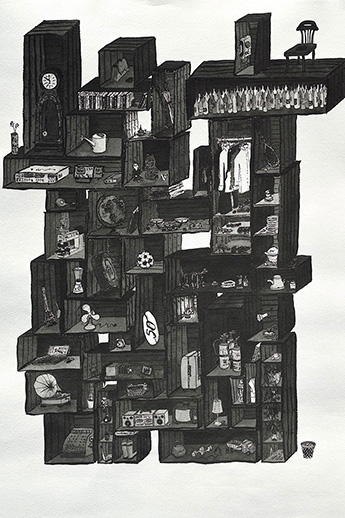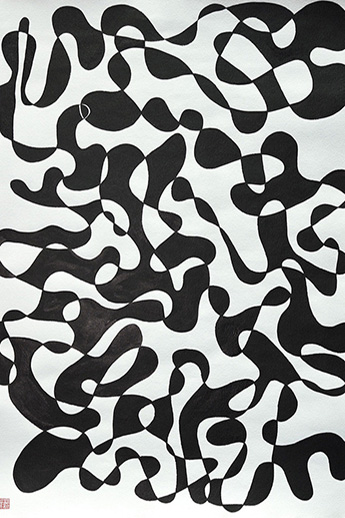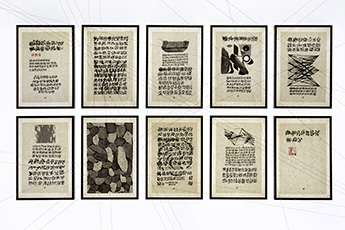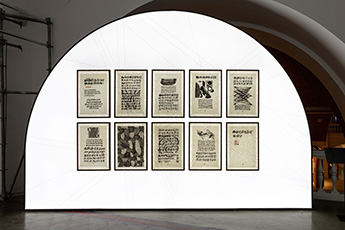Creativity is something one can't predict
Nobel laureate in physics speaks about similarities between science and art.
Konstantin Novoselov engaged in painting when he was a serious scientist already, since he was illustrating his own research papers. Novoselov admits, he took interest in Chinese graphics due to the lack of time and diligence, and also because this technique let him paint not from life but his feelings. He gained worldwide fame following the discovery of graphene: in 2010 he and Andrei Geim won the Nobel prize for it. It also spiked interest to the physicist’s art, even more so considering that Novoselov uses graphene to paint. In June and July Hermitage Museum hosted an exhibition named “Artificial Intelligence and Intercultural Dialogue,” featuring Novoselov among others.
- Can you explain what graphene is in simple terms?
- Graphene is one atomic layer of graphite. You need to refine graphite more and more to produce it. Graphite is a layered material, this is why you can draw with a pencil – it easily flakes away, and the pencil line you see actually consists of these flakes. If you peel increasingly thinner flakes, you will end up with one atomic layer, which is graphene. Surprisingly, one or two layers follow completely different patterns, the same applies to three layers. Properties vary dramatically. When you keep just a single layer, the properties of the electrons are very, very uncommon. This is why physicists like it so much.
- What do they do with it?
- First, it's very handy to work with since it's extremely stable. Any student can produce a great quality sample of graphene in two minutes using a scotch tape. It's a very democratic material with highly uncommon properties. Its electronic properties have a long-range changeability.
- So you use the ink made of small pieces of graphene to paint?
- I do. I had to modify it slightly to enhance its ability to moist the rice paper I paint on. One of the start-ups from the University of Manchester has a plant in China that produces printed electronics based on graphene and other materials. Among other things, I buy graphene paint from them, modify it a bit, and paint.
- When did you take a conscious interest in art?
- I was always keen to learn how to paint. I always felt I could; yet I was stalling myself, probably thinking I lack talent, and doing something for no special reason was not good enough. So up to a certain point I just held myself back and took no attempts. I began to paint when I was a scientist already. The main product of a scientist is a paper. A discovery is not, a product is when you take a formula and follow it up with a paper to explain it to other people. And any paper always calls for illustrations, since it's the easiest way to communicate something to people. I was always making these illustrations myself. I enjoyed painting to make it beautiful, clear and easily understandable. I held back this passion to some extent, but at some point I just began to paint.
- Did you parents make artistic education available for you as a child?
- It's a bit of a shame that I have no artistic education. My mother believed neither me, nor my sister needed to be forced, so we never studied in music or art schools. In this respect we grew up as perfectly normal kids spending time outside. But it got me a great technical background. I used to spend a lot of time with my father, and we were doing racing – buggy for him, and go-carting for me. Of course, we had to make everything ourselves using whatever was available, we used to grind or weld a lot.
- So later you studied Chinese graphics primarily for yourself?
- Exclusively for myself.
- Why does the Chinese style attract you?
- One of the reasons I paint Chinese style is the lack of time, and probably the lack of diligence. I need to know the answer right here, right now. Again, this is why I chose that very area of science I study. Various science domains function very differently. There are huge scientific projects involving dozens of thousand of people. You can run it for five years, and it still will not be over. I’m not a huge fan of it. It’s not a bad science but it’s a mismatch with my temper.
- Have you ever assumed to become an artist when studied physics as a student?
- You probably won’t believe it, but I never assumed that I’d become a scientist. I graduated in 1997, and it was common back then to earn money and do business. I took it quite seriously, and effectively studied very little. We had a construction company specializing on roofing. I spent several years basically only attending the institute to pass exams, devoting all my time to earning money. Thank God, later I got tired of it, returned to do a paper and became a scientist. The business just bored me.
- You said in one of your interviews that art required no explanation.
- I am absolutely positive about it.
- But we have just seen an incredibly complex exhibition featuring so many machines; there are some totally incomprehensible things.
- Do you really need to comprehend? You will tell an artwork from a simple drawing. I can’t explain what features help you do it, but it’s something deep inside, something that this particular painting emits. I mentioned before that I learned Chinese art drawing lotuses and bamboos.
- And then you drew a bicycle.
- I did. Later [the Chairman of Viennacontemporary, the fair of contemporary art] Dima Aksenov bought it from me. You might think – it’s a bicycle, I can paint so many more of these. But since then I couldn’t, and I don’t know why. I am a physicist, not a metaphysicist. I am absolutely rational. There are no deviances in my mind, I keep on publishing research papers as I did before. But bicycles are a problem. And you know, I could tell you a story about this bicycle, but I’d never be able to explain what were the differences between the two.
Konstantin Novoselov’s artworks
- Let’s speak about the Obvious – the most successful group that utilizes AI today. I mean, it would never boom so much and sell an artwork at Christie’s last October earning $432,500 if they didn’t explain that AI created the images, and it was a full member of an artistic group. It’s an example of a specific explanation, which benefits both the artist, and the history of art.
- It does benefit the artist but I'm not sure if it benefits the history of art. I believe, AI will stay in the art and will find some applications. What we are seeing now is a learning process as we try to understand how to do it. You may see many lookalike artworks. It's a period we need to get over. I think, AI will become one of the tools, it's a very powerful one. It's already here to stay. But is it necessary to explain what it does? I don't think so.
- What if it develops enough to produce fine and conceptual works?
- If it produces fine artworks, it’s one thing but I believe you’ll be able to tell the true art from something else. You can already tell production from genuine art today.
- Do you see yourself in science art?
- I’ve been thinking about it, and my opinion is, we have enough challenges in science, and enough challenges in art. If they mix unaided – I say it’s great. Why I chose Chinese art of all others? When I approach the canvas, the paper, and pick a brush it’s not always the case that I know what I am about to paint. If it relates to science, I say it’s great, but I will never force myself to paint something related to science. Why would I want to set some additional narrow bounds for myself? Trust me, there are not so many artworks that I like, may be 10-20 a year. I never demonstrate the ones I hate to anyone, I just throw them away.
- What role did Dmitry Aksenov play in your fate as an artist?
- Dima has helped me a lot. He helped me with some exhibitions, which led to the sales of my artworks. And I thought: may be I can become an artist physicist instead of a physicist artist, or just an artist? But then at some point I realized that I didn’t want it, and it even terrified me. I enjoy the opportunity to paint whenever I want a lot. And if I struggle today, tomorrow and for an entire month, I don’t care. It means, my brain works on something else, it is more focused on physics right now. But if my existence depended on it, I would worry and cut corners here and there. Currently I exhibit, do and sell only the paintings I truly like.
- Are you interested in exhibitions, in sales?
- I am only interested in the fact that each exhibition requires some preparations, and as soon as you start thinking about it the process drives you to a certain proper disposition. This is what I like about it. In particular, recently I began to prepare for an exhibition in Auvergne, France – it’s a group exhibition with a contemporary artist, Kate Daudy, we have a bunch of projects together. This exhibition in Auvergne will be hosted at a paper mill, one of the oldest, or may be even the oldest mill ever. It’s a very small facility where they make paper by hand. Kate introduced me to these people, and we thought, “why not stage a small exhibition there?” I tried painting on the paper they make, and the result was different from rice paper (which I commonly use).
- Was it graphene painting too?
- Graphene and ink produce a different result. The feeling is different, and so is the technique compared to rice paper. The blotting capacity is much lower but it lets you use alternative methods. I learned how to work with it, unwanted paint can be removed, and it allows for new techniques to emerge. When I began to prepare for this exhibition some time ago, I painted a lot using this very paper.
- Does it mean you aim to develop your skills further as a graphic artist?
- I have always been impressed by Chinese graphics and calligraphy. In this sense they are very similar to science. Say, you need to measure water refraction in a glass. There are people around talking, producing vibrations, the surface is uneven, and the water is sparkling. But when you conduct this experiment, you need to remove anything unwanted while keeping what you need – the index that shows the refraction of pure water. This is what the experimentalist’s art is all about – reduce all unnecessary effects and enhance the necessary ones. Chinese painting is based on the same principle. You never paint from life, you paint your feeling.
There are Chinese paintings that use as much as five to ten strokes to translate an enormously vast range of feelings. For me it’s a long way to go, a brilliant skill of wielding a brush but also your own mind. This ability to isolate the essence is crucial both in physics, and in Chinese painting.
- Aren’t you annoyed with always being introduced as an artist and Nobel laureate in physics? And you also are a knight.
- Yes, and it's a double because I was knighted in Holland too. It jars on my ears a little. For example, Kate Daudy had a service in St. Paul's Cathedral in London to honour her refugee support efforts. I delivered a sermon, and one of the clerics was naming everyone else in a common manner but called me Sir Konstantin. I tried to explain him that a simple “Kostya” would do, or even simpler, Costa, like the coffee brand. But he insisted and named me Sir Costa. So Kate had to intervene and ask him to not “sir” me anymore, and just call me Kostya.
- In your opinion, how do your merits impact the perception of your artworks?
- It is not much that I can do about it – I know there is an impact. Therefore the most important thing is that I send my artworks to my trainer in China. He will never lie. He will be honest in telling crap from a good job. I recognize very clearly that there are lots and lots of people more talented than me. But acknowledgement is a good thing. Sometimes suffering is not. There is a degree of importance for it, but sometimes a praise plays a very important role. Artists have to be treated very carefully for they are extremely sensitive.
- Are scientists less sensitive?
- They are very, very sensitive. This is why the path matters a lot, but it’s very hard to predict what is more important, the talent or the working ability. When I employ a student I assess both. With no talent or decent knowledge one is no good as a scientist. But one has to work so, so much, and I'm not going to employ anyone intending otherwise. I believe it's also the case for art. Talent matters, but hard working matters as well.
To read the full article, see Vedomosti website.
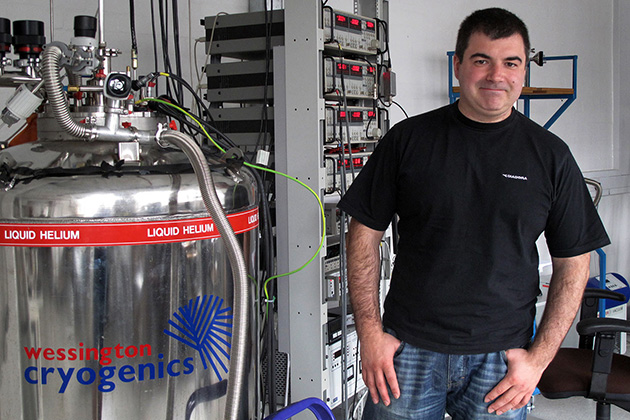 Nobel laureate in physics - Konstantin Novoselov
Nobel laureate in physics - Konstantin NovoselovFor the largest part ill handwriting in the world is caused by hurry.
(Lewis Carroll)
